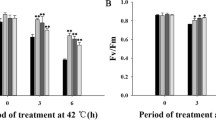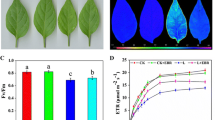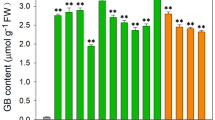Abstract
Key message
Glycinebetaine alleviates chilling stress by protecting photosystems I and II in BADH -transgenic and GB-treated tomato plants, which can be an effective strategy for improving crop chilling tolerance.
Abstract
Tomato (Solanum lycopersicum) is one of the most cultivated vegetables in the world, but is highly susceptible to chilling stress and does not naturally accumulate glycinebetaine (GB), one of the most effective stress protectants. The protective mechanisms of GB on photosystem I (PSI) and photosystem II (PSII) against chilling stress, however, remain poorly understood. Here, we address this problem through exogenous GB application and generation of transgenic tomatoes (Moneymaker) with a gene encoding betaine aldehyde dehydrogenase (BADH), which is the key enzyme in the synthesis of GB, from spinach. Our results demonstrated that GB can protect chloroplast ultramicrostructure, alleviate PSII photoinhibition and maintain PSII stability under chilling stress. More importantly, GB increased the electron transfer between QA and QB and the redox potential of QB and maintained a high rate of cyclic electron flow around PSI, contributing to reduced production of reactive oxygen species, thereby mitigating PSI photodamage under chilling stress. Our results highlight the novel roles of GB in enhancing chilling tolerance via the protection of PSI and PSII in BADH transgenic and GB-treated tomato plants under chilling stress. Thus, introducing GB-biosynthetic pathway into tomato and exogenous GB application are effective strategies for improving chilling tolerance.







Similar content being viewed by others
References
Alia KY, Sakamoto A, Nonaka H, Hayashi H, Saradhi PP, Chen THH, Murata N (1999) Enhanced tolerance to light stress of transgenic Arabidopsis plants that express the codA gene for a bacterial choline oxidase. Plant Mol Biol 40:279–288
Allakhverdiev SI, Nishiyama Y, Takahashi S, Miyairi S, Suzuki I, Murata N (2005) Systematic analysis of the relation of electron transport and ATP synthesis to the photodamage and repair of photosystem II in Synechocystis. Plant Physiol 137:263–273
Allen DJ, Ort DR (2001) Impacts of chilling temperatures on photosynthesis in warm-climate plants. Trends Plant Sci 6:36–42
Baker NR (2008) chlorophyll fluorescence: a probe of photosynthesis in vivo. Annu Rev Plant Biol 59:89–113
Bartoli CG, Simontacchi M, Tambussi E, Beltrano J, Montaldi E, Puntarulo S (1999) Drought and watering-dependent oxidative stress: effect on antioxidant content in Triticum aestivum L. leaves. J Exp Bot 50:375–383
Bednaříková M, Váczi P, Lazár D, Barták M (2020) Photosynthetic performance of Antarctic lichen Dermatocarpon polyphyllizum when affected by desiccation and low temperatures. Photosynth Res 145:159–177
Bradford MM (1976) A rapid and sensitive method for the quantitation of microgram quantities of protein utilizing the principle of protein-dye binding. Anal Biochem 72:248–254
Chen THH, Murata N (2002) Enhancement of tolerance of abiotic stress by metabolic engineering of betaines and other compatible solutes. Curr Opin Plant Biol 5:250–257
Chen THH, Murata N (2008) Glycinebetaine: an effective protectant against abiotic stress in plants. Trends Plant Sci 13:499–505
Chen THH, Murata N (2011) Glycinebetaine protects plants against abiotic stress: mechanisms and biotechnological applications. Plant Cell Environ 34:1–20
Croce R, van Amerongen H (2020) Light harvesting in oxygenic photosynthesis: structural biology meets spectroscopy. Science 369:eaay2058
Derks AK, Bruce D (2018) Rapid regulation of excitation energy in two pennate diatoms from contrasting light climates. Photosynth Res 1382:149–165
Derks A, Schaven K, Bruce D (2015) Diverse mechanisms for photoprotection in photosynthesis. Dynamic regulation of photosystem II excitation in response to rapid environmental change. BBA Bioenerget 1847:468–485
Ding YL, Shi YT, Yang SH (2020) Molecular regulation of plant responses to environmental temperatures. Mol Plant 13:544–564
Elstner EF, Heupel A (1976) Inhibition of nitrite formation from hydroxylammoniumchloride: a simple assay for superoxide dismutase. Anal Biochem 70:616–620
Farooq M, Aziz T, Hussain M, Rehman HU, Jabran K, Khan MB (2008) glycinebetaine improves chilling tolerance in hybrid maize. J Agron Crop Sci 1942:152–160
Giannopotitis CN, Ries SK (1977) Superoxide dismutase in higher plants. Plant Physiol 59:309–314
Gong ZZ, Xiong LM, Shi HZ, Yang SH, Herrera-Estrella LR, Xu GH, Chao DY, Li JR, Wang PY, Guo Y, Zhu JK (2020) Plant abiotic stress response and nutrient use efficiency. Sci China Life Sci 63:635–674
Guo YJ, Lu YP, Goltsev V, Strasser RJ, Kalaji HM, Wang H, Wang XX, Chen SG, Qiang S (2020) Comparative effect of tenuazonic acid, diuron, bentazone, dibromothymoquinone and methyl viologen on the kinetics of Chl a fluorescence rise OJIP and the MR820 signal. Plant Physiol Biochem 156:39–48
Huang W, Yang YJ, Zhang SB, Liu T (2018) Cyclic electron flow around photosystem I promotes ATP synthesis possibly helping the rapid repair of photodamaged photosystem II at low light. Front Plant Sci 9:239
Huang S, Zuo T, Ni W (2020) Important roles of glycinebetaine in stabilizing the structure and function of the photosystem II complex under abiotic stresses. Planta 251:36
Jin SH, Li XQ, Hu JY, Wang JG (2009) Cyclic electron flow around photosystem I is required for adaptation to high temperature in a subtropical forest tree, Ficus concinna. J Zhejiang Univ Sci 10:784–790
Johnson GN (2011) Physiology of PSI cyclic electron transport in higher plants. BBA Bioenerget 18073:384–389
Joliot P, Johnson GN (2011) Regulation of cyclic and linear electron flow in higher plants. Proc Natl Acad Sci USA 10832:13317–13322
Kudoh H, Sonoike K (2002) Irreversible damage to photosystem I by chilling in the light: cause of the degradation of chlorophyll after returning to normal growth temperature. Planta 215:541–548
Li MF, Li ZM, Li SF, Guo SJ, Meng QW, Li G, Yang XH (2014) Genetic engineering of glycinebetaine biosynthesis reduces the heat-enhanced photoinhibition by enhancing antioxidative defense and alleviating lipid peroxidation in tomato. Plant Mol Biol Rep 32:42–51
Li CY, Zhang TP, Feng PW, Li DX, Brestic M, Liu Y, Yang XH (2021a) Genetic engineering of glycinebetaine synthesis enhances cadmium tolerance in BADH-transgenic tobacco plants via reducing cadmium uptake and alleviating cadmium stress damage. Environ Exp Bot 191:104602
Li DX, Wang MW, Zhang TP, Chen X, Li CY, Liu Y, Brestic M, Chen THH, Yang XH (2021b) Glycinebetaine mitigated the photoinhibition of photosystem II at high temperature in transgenic tomato plants. Photosynth Res 147:301–315
Lichtenthaler H, Wellburn A (1983) Determination of total carotenoids and chlorophylls a and b of leaf in different solvents. Biochem Soc Trans 11:591–592
Lima-Melo Y, Alencar VTCB, Lobo AKM, Sousa RHV, Tikkanen M, Aro EM, Silveira JAG, Gollan PJ (2019) Photoinhibition of photosystem I provides oxidative protection during imbalanced photosynthetic electron transport in Arabidopsis thaliana. Front Plant Sci 10:916
Maehly AC, Chance B (2006) The assay of catalases and peroxidases. Methods Biochem Anal 1:357–424
Ming R, Zhang Y, Wang Y, Khan M, Dahro B, Liu JH (2021) The JA-responsive MYC2-BADH-like transcriptional regulatory module in Poncirus trifoliata contributes to cold tolerance by modulation of glycine betaine biosynthesis. New Phytol 229:2730–2750
Montepietra D, Bellingeri M, Ross AM, Scotognella F, Cassi D (2020) Modelling photosystem I as a complex interacting network. J R Soc Interface 17:20200813
Murata N, Nishiyama Y (2018) ATP is a driving force in the repair of photosystem II during photoinhibition. Plant Cell Environ 412:285–299
Murata N, Takahashi S, Nishiyama Y, Allakhverdiev SI (2007) Photoinhibition of photosystem II under environmental stress. BBA Bioenerget 1767:414–421
Nishiyama Y, Murata N (2014) Revised scheme for the mechanism of photoinhibition and its application to enhance the abiotic stress tolerance of the photosynthetic machinery. Appl Microbiol Biotechnol 9821:8777–8796
Ogawa KI, Kanematsu S, Asada K (1997) Generation of superoxide anion and localization of CuZn–superoxide dismutase in the vascular tissue of spinach hypocotyls: their association with lignification. Plant Cell Physiol 38:1118–1126
Ohnishi N, Murata N (2006) Glycinebetaine counteracts the inhibitory effects of salt stress on the degradation and synthesis of D1 protein during photoinhibition in Synechococcus sp. PCC 7942. Plant Physiol 1412:758–765
Park EJ, Jeknić Z, Sakamoto A, DeNoma J, Yuwansiri R, Murata N, Chen THH (2004) Genetic engineering of glycinebetaine synthesis in tomato protects seeds, plants, and flowers from chilling damage. Plant J 40:474–487
Park EJ, Jeknić Z, Chen THH (2006) Exogenous application of glycinebetaine increases chilling tolerance in tomato plants. Plant Cell Physiol 47:706–714
Perreault F, Dionne J, Didur O, Juneau P, Popovic R (2011) Effect of cadmium on photosystem II activity in Chlamydomonas reinhardtii: alteration of O-J–I–P fluorescence transients indicating the change of apparent activation energies within photosystem II. Photosynth Res 107:151–157
Rhodes D, Rich PJ, Brunk DG, Ju GC, Rhodes JC, Pauly MH, Hansen LA (1989) Development of two isogenic sweet corn hybrids differing for glycinebetaine content. Plant Physiol 91:1112–1121
Roach T, Krieger-Liszkay A (2014) Regulation of photosynthetic electron transport and photoinhibition. Curr Protein Pept Sci 154:351–362
Salvatori E, Fusaro L, Gottardini E, Pollastrini M, Goltsev V, Strasser RJ, Bussotti F (2014) Plant stress analysis: application of prompt, delayed chlorophyll fluorescence and 820 nm modulated reflectance. Insights from independent experiments. Plant Physiol Biochem 85:105–113
Sasi S, Venkatesh J, Daneshi RF, Gururani MA (2018) Photosystem II extrinsic proteins and their putative role in abiotic stress tolerance in higher plants. Plants Basel 74:100
Schägger H, von Jagow G (1991) Blue native electrophoresis for isolation of membrane protein complexes in enzymatically active form. Anal Biochem 199:223–231
Solymosi D, Nikkanen L, Muth-Pawlak D, Fitzpatrick D, Vasudevan R, Howe CJ, Lea-Smith DJ, Allahverdiyeva Y (2020) Cytochrome cM decreases photosynthesis under photomixotrophy in Synechocystis sp. PCC 6803. Plant Physiol 183:700–716
Sonoike K, Kamo M, Hihara Y, Hiyama T, Enami I (1997) The mechanism of the degradation of psaB gene product, one of the photosynthetic reaction center subunits of photosystem I, upon photoinhibition. Photosynth Res 53:55–63
Strasser RJ, Tsimilli-Michael M, Qiang S, Goltsev V (2010) Simultaneous in vivo recording of prompt and delayed fluorescence and 820-nm reflection changes during drying and after rehydration of the resurrection plant Haberlea rhodopensis. Biochim Biophys Acta (BBA) Bioenerg 1797:1313–1326
Strauss AJ, Krüger GHJ, Strasser RJ, Heerden PDRV (2006) Ranking of dark chilling tolerance in soybean genotypes probed by the chlorophyll a fluorescence transient o–j–i–p. Environ Exp Bot 562:147–157
Tadmor Y, Raz A, Reikin-Barak S, Ambastha V, Shemesh E, Leshem Y, Crane O, Stern RA, Goldway M, Tchernov D, Liran O (2021) Metamitron, a photosynthetic electron transport chain inhibitor, modulates the photoprotective mechanism of apple trees. Plants (basel) 10:2803
Takahashi S, Milward SE, Fan DY, Chow WS, Badger MR (2009) How does cyclic electron flow alleviate photoinhibition in Arabidopsis? Plant Physiol 149:1560–1567
Thierry J, Cournac L, Peltier G, Havaux M (2002) Cyclic electron flow around photosystem I in C3 plants. In vivo control by the redox state of chloroplasts and involvement of the NADH-dehydrogenase complex. Plant Physiol 128:760–769
Tikkanen M, Mekala NR, Aro EM (2014) Photosystem II photoinhibition–repair cycle protects photosystem I from irreversible damage. BBA Bioenerget 1837:210–215
Wang P, Duan W, Takabayashi A, Endo T, Shikanai T, Ye JY, Mi H (2006) Chloroplastic NAD(P)H dehydrogenase in tobacco leaves functions in alleviation of oxidative damage caused by temperature stress. Plant Physiol 141:465–474
Wang F, Wu N, Zhang LY, Ahammed GJ, Chen XX, Zhou J, Xia XJ, Shi K, Yu JQ, Foyer CH, Zhou YH (2018) Light signaling-dependent regulation of photoinhibition and photoprotection in tomato. Plant Physiol 176:1311–1326
Wang F, Yan J, Ahammed GJ, Wang X, Bu X, Xiang H, Li Y, Lu J, Liu Y, Qi H, Qi M, Li T (2020) PGR5/PGRL1 and NDH mediate far-red light-induced photoprotection in response to chilling stress in tomato. Front Plant Sci 11:669
Wei DD, Zhang W, Wang CC, Meng QW, Li G, Chen THH, Yang XH (2017) Genetic engineering of the biosynthesis of glycinebetaine leads to alleviate salt-induced potassium efflux and enhances salt tolerance in tomato plants. Plant Sci 257:74–83
Yamori W, Shikanai T (2016) Physiological functions of cyclic electron transport around photosystem I in sustaining photosynthesis and plant growth. Annu Rev Plant Biol 67:81–106
Yang XH, Liang Z, Lu CM (2005) Genetic engineering of the biosynthesis of glycinebetaine enhances photosynthesis against high temperature stress in transgenic tobacco plants. Plant Physiol 138:299–309
Yang XH, Wen XG, Gong HM, Lu QT, Yang ZP, Tang YL, Liang Z, Lu CM (2007) Genetic engineering of the biosynthesis of glycinebetaine enhances thermotolerance of photosystem II in tobacco plants. Planta 225:719–733
Yang XH, Liang Z, Wen XG, Lu CM (2008) Genetic engineering of the biosynthesis of glycinebetaine leads to increased tolerance of photosynthesis to salt stress in transgenic tobacco plants. Plant Mol Biol 66:73–86
Zeng R, Li Z, Shi Y, Fu D, Yin P, Cheng J, Jiang C, Yang S (2021) Natural variation in a type-A response regulator confers maize chilling tolerance. Nat Commun 12:4713
Zhang L, Paakkarinen V, van Wijk KJ, Aro EM (1999) Co-translational assembly of the D1 protein into photosystem II. J Biol Chem 247:16062–16067
Zhang TP, Li ZM, Li DX, Li CY, Wei DD, Li SF, Liu Y, Chen THH, Yang XH (2020) Comparative effects of glycinebetaine on the thermotolerance in codA- and BADH-transgenic tomato plants under high temperature stress. Plant Cell Rep 39:1525–1538
Zhang TP, Zhang WX, Li DX, Zhou FL, Chen X, Li CY, Yu S, Brestic M, Liu Y, Yang XH (2021) Glycinebetaine: a versatile protectant to improve rice performance against aluminium stress by regulating aluminium uptake and translocation. Plant Cell Rep 40:2397–2407
Zhu JK (2016) Abiotic stress signaling and responses in plants. Cell 167:313–324
Funding
Funding for this research were provided by the National Natural Sciences Foundation of China (31870216, 31470341), Open project of State Key Laboratory of Crop Biology of Shandong Agriculture University (2017KF10) and Science and Technology Innovation Project of Colleges and Universities in Shanxi Province (2020L0542).
Author information
Authors and Affiliations
Contributions
XY conceived and supervised the project, and XY, YL and DW designed the experiments. DW and TZ performed most of the experiments. BW, HZ, MM and SL performed some of the experiments. DW, TZ and XY analyzed data and wrote the manuscript. THHC, MB and YL gave positive suggestion about this article. All authors read and approved the manuscript.
Corresponding authors
Ethics declarations
Conflict of interest
The authors have no conflicts of interest to declare.
Additional information
Communicated by Chun-Hai Dong.
Publisher's Note
Springer Nature remains neutral with regard to jurisdictional claims in published maps and institutional affiliations.
Supplementary Information
Below is the link to the electronic supplementary material.
Rights and permissions
About this article
Cite this article
Wei, D., Zhang, T., Wang, B. et al. Glycinebetaine mitigates tomato chilling stress by maintaining high-cyclic electron flow rate of photosystem I and stability of photosystem II. Plant Cell Rep 41, 1087–1101 (2022). https://doi.org/10.1007/s00299-022-02839-0
Received:
Accepted:
Published:
Issue Date:
DOI: https://doi.org/10.1007/s00299-022-02839-0




